Jukka Heikinheimo, OH2BR
Issue 66, August 2000
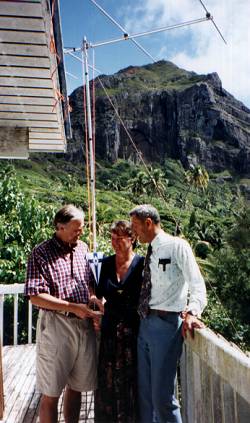 OH2BR
presenting the SRAL pennant to his hosts Tom, VP6TC and Betty, VP6YL on their
balcony, following his successful operation as VP6BR. The photo also shows the
six-metre yagi in its new location, with Fletcher Christian’s Cave in the
background.
OH2BR
presenting the SRAL pennant to his hosts Tom, VP6TC and Betty, VP6YL on their
balcony, following his successful operation as VP6BR. The photo also shows the
six-metre yagi in its new location, with Fletcher Christian’s Cave in the
background.
Deciding whether to include six metres into my VP6BR DXpedition programme or not was an easy task. True, I had operated on six metres only briefly in 1989-91, making some European and a few DX contacts such as VK8ZLX, VK3OT and G3GJQ/5N. But after that I moved to St. Petersburg, Russia, where Six was out of the question. But my interest in ‘The Magic Band’ remained. After returning to Finland I made some 150 QSOs, mostly inside Europe, during the summer openings in 1995-97 before going QRT on Six after selling my FT-736 and 200W linear amplifier and moving to another location.
What made it easy to decide was the fact that at the SRAL summer camp in July 1999 I had bought an ICOM IC-706MkII to serve as a spare rig ready to replace my Yaesu FT-1000MP in case of malfunction. It covered six metres as well and only the question of finding a good antenna to go with it was left open. I still had my seven-element KLM yagi but I considered it to be too big to be shipped to Auckland.
My visit to the RSGB HF Convention in October was crucial to VP6BR six-metre operation. I met with many British six-metre enthusiasts and received a lot of encouragement from them. I felt that there was strong interest in putting VP6 back onto the world’s six-metre map once again after the successful operation resulting in over 300 QSOs by VR6BB (Nob, JF2MBF) in 1993. He had worked all continents except Europe.
The UK Six Metre Group decided to donate a five-element sturdy yagi designed by Ron, PA1ZX and distributed by his company called ZX Yagis (www.zx-yagi.com)
Getting there
The yagi arrived in Auckland in time to be released by the customs just before the ship sailed. Martin, ZL1ANJ had to do an extra trip to the airport customs to collect the antenna and get it to the ship. The ETD of Queensland Star had been moved from Jan 19th to Jan 17th in very short notice. The six-metre gang was lucky to have the customs on their side, working so fast on that Monday morning!
I started my operation from Pitcairn on Jan 25th, 2000, as soon as I had some HF dipoles strung up at the QTH of my host Tom, VP6TC in Adamstown. The final location for my station was the maritime radio station on top of the island. After assembling the two HF multiband yagis and working down some of the initial pileups it was time to assemble the six-metre yagi, tune it to the band with my CIA-HF antenna analyser and start calling.
As I wanted to keep the feedline short, I installed the yagi on a five-metre aluminium mast next to the radio station building on it’s northern side, facing North to California - from where I expected to hear the first signals. But this proved to be a much more difficult task than I had been anticipating.
I did not expect anything phenomenal to happen on Six, as Pitcairn is a long way from all other active six-metre stations. Therefore I was quite astonished to work Avelino EH8BPX, from the Canary Islands as my first QSO on Feb 10th. Avelino soon became the beacon for me and we had numerous contacts during my three-month stay on Pitcairn Island. His signal was always very strong; I believe his QTH at 500m asl has something to do with his fabulous signal.
February
During February I worked only 23 QSOs on Six, mostly from Central and South America which appeared to be the easiest targets for VP6BR. Besides Avelino EH8BPX, contacts were made with HK3YH, HP2CWB, HP3XUG, XE1BEF, XE1L, V31PC and a bunch of PYs led by PY2XB who appeared to be among the most active. CT3HF made a pleasant appearance on Feb 17th.
On Feb 15th there was an evening opening to Hawaii and I was able to log KH7R, KH7U, KH6RU and KH6HAK. Later the Hawaiian path opened more regularly and several other stations there were worked, too.
One could have been content with the above QSOs and considered six metres not to be a very interesting band. However, I knew that The Magic Band did not carry its name without due reason. I also knew that the sunspot maximum was right there with me so I kept on listening and calling CQ.
March
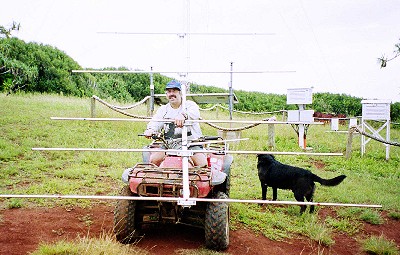 The
chairman of the VP6PAC club, Dave Brown, transporting the Yagi after the VP6BR
station had been dismantled.
The
chairman of the VP6PAC club, Dave Brown, transporting the Yagi after the VP6BR
station had been dismantled.
The month of March continued to produce more Central and South American QSOs. New countries were added to the VP6BR six metre log such as HR, PY0, TI, YV and ZP. The Canary Islands were now represented, as well as by EH8BPX, by EH8BYR and EA8/EH5CPU. CN8TW from Morocco was worked on March 6th.
March 13th was a turning point for VP6BR 50MHz activity. The band finally opened for the West Coast and ten stations were worked in a row between 2230 and 2305z. This was a most promising sign and called for more effort in listening and calling CQ on the band. As Diana, KB6NAN likes to express it: "Make noise!". She must be right as during this short opening she made her first appearance in the VP6BR six-metre log.
On March 15th a further step forward was made when I contacted WP4O and KP2L on CW at 2214z. Now the East Coast from W4 to W1 seemed to be just round the corner and it could only be a matter of time to reach out to the far end of the US from Pitcairn.
The final blow in the eastern direction was made on March 21st. Faint, but readable CW signals were copied and reports exchanged at 2056z with JY9NX, then 5B4AGC and 4X1RF. Later, between 2200 and 2230z three Maltese stations, 9H1CG, 9H1BT and 9H1PA made it in the log of VP6BR. At 2340z this Mediterranean tour was finished by finally contacting Jose, EH7KW, after weeks of daily skeds. Jose later broke in a couple of times on other bands telling me that he had hard time getting sleep after that QSO. The joy he felt was overwhelming!
The six metre monitoring frequency on ten metres, 28885 kHz, was essential in co-ordinating efforts with many stations looking for a QSO with VP6BR. Diana, KB6NAN was usually there and had the latest information on what was happening on the band at any given time.
J68AS came in two hours later to round up this magnificent session and to boost the VP6BR country total by one more.
April
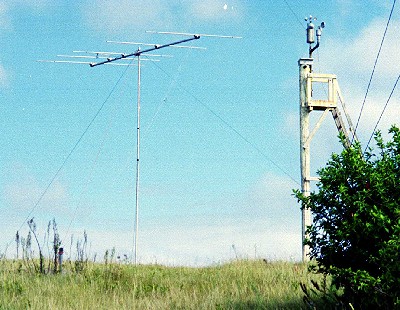 The
final location of the six-metre yagi was a shallow sandpit seen to the left of
the top section of a big Norfolk pine. To the right of the yagi is a 5m-high
white wooden pole with steps for climbing up and taking weather measurements.
The
final location of the six-metre yagi was a shallow sandpit seen to the left of
the top section of a big Norfolk pine. To the right of the yagi is a 5m-high
white wooden pole with steps for climbing up and taking weather measurements.
My last month of operation, April, started with promising QSOs with TG9NX, WP4O, ZF1DC, K2RTH in Florida, 8P9HW and V31PC on the 2nd between 2100 and 2230z. But I had the feeling something was not working right for me. I had not heard any JAs, ZLs or VKs!
To the west from the 50MHz yagi, as it was standing at the north side of the radio station building, there was a small hill, perhaps 7m higher while the antenna mast was only 5m high. So I decided to move the antenna to the top of that hill, next to the meteorological set-up with a wooden pole and ladders (see photo). Now I should have an unobstructed view in ALL directions! However, this meant that I had to be content with 60m of coaxial cable instead of 30m.
This proved to be a wise decision as I immediately started hearing and working stations in the western direction. First, on April 4th, I worked ZL3TY, ZL3GS and KH8/N0JK, and the following day 39 JA stations made it into VP6BR log between 00 and 04z. Too bad I lost most of this window in favour of my dinner in Adamstown.
Next morning local time (Apr 5th from 17 to 19z) told me to be alert on Six as I started the day with three Indonesians, seven Puerto Ricans and K2RTH again. Something big was definitely ‘cooking’.
A few stations in Florida followed. 9H1CG was contacted again at 2141z so the path was open for Europe. Instead, a short string of Texans rounded up that day, but this was not enough for me. I was ready for a major opening to the States as I had already got a taste for it.
FOØTOH, KP4EIT, KH8/NØJK and LU3HR were caught on April 6th. But the big opening was just one night away…
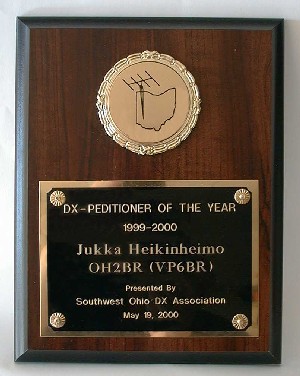 Following
his return from Pitcairn, OH2BR/VP6BR was presented with the "DXpeditioner
of the year 1999-2000" award at the Dayton Hamvention.
Following
his return from Pitcairn, OH2BR/VP6BR was presented with the "DXpeditioner
of the year 1999-2000" award at the Dayton Hamvention.
On April 7th, I woke up at 8 o’clock local time (16z) after only three hours of sleep. I had been working heavy pileups of JA and USA on the 40 and 30 m bands during the early morning hours. I turned the six-metre rig on. There it was! Six metres was sizzling with strong Stateside signals all over the band!
Between 1613 and 1937z more than 200 North American stations were worked in an HF-like SSB pileup with strong signals appearing and disappearing. W1LP was the first station contacted, followed by K8MFO, N1ZUK and KP4EIK. The first 40 minutes of the opening favoured W1, 2, 3, 4, 8 and 9. VE3KZ, VA3POS, a few LUs and XE1EED made it through the US pileup. Later the opening became wider and zeros and fives started coming in. Even a few sixes and sevens were logged so that opening appeared to be coast to coast. What a treat!
When the NA opening dried out I was too pumped up with adrenalin to quit operating on Six. I kept listening and calling CQ. In the local afternoon, between 2040 and 2400z, more juicy ones, such as 3D2AG, H44PT, YN1SW, CO2OJ, P43P, 3D2CM and J87AB as well as many VKs and ZLs were logged.
But this amazing day of good news on Six metres was not over. More was to come. I had always been hoping for a good JA opening and at 0030z that dream became a reality. 250 JAs were quickly worked on CW until the propagation suddenly died out for JA at 0220z. That day certainly was one of the historic days of Six, at least for Pitcairn Island.
I was hoping that the next day would be even better or at least the same. It was not so but I still managed to work a few more YB, W2-4, 7, 8 and lots of CX, LU, PY, VK, ZL and ZP stations. FK8CA and P29PL were the rare catches of the day.
The next opening on Six was not until April 17th, bringing 18 more JAs into the log. On the same day my active six-metre liaison Diana, KB6NAN was worked again on Six. She was accompanied only by N6VLV.
April 19th marked the wrap-up time for VP6BR activities. ZK2XO was worked for a new one at 0025z, followed by 3D2AG and PY5EW. The strong signal from the PJ2/WZ8D beacon had prompted us to make a sked and it was completed successfully at 2235z. XE1/NP2AQ and ZF1DC followed. The last six metre QSO from VP6BR was KH8/N5OLS on April 20 at 0024z.
Conclusions
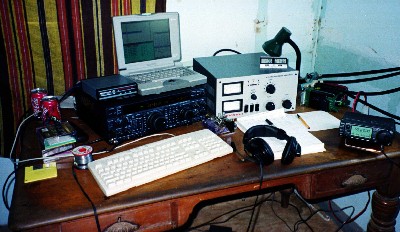 VP6BR
station layout at the radio station on top of the island. On the right you can
see the IC-706MkII used on six metres and usually switched on at all times VP6BR
was QRV. Whenever there was traffic on 50.110, Jukka stopped the HF pileup and
listened on Six to investigate.
VP6BR
station layout at the radio station on top of the island. On the right you can
see the IC-706MkII used on six metres and usually switched on at all times VP6BR
was QRV. Whenever there was traffic on 50.110, Jukka stopped the HF pileup and
listened on Six to investigate.
The total number of six metre QSOs made by VP6BR was 755. This was done as a side project to the otherwise HF-dominated DXpedition. ICOM IC-706MkII was usually switched on and monitoring 50.110 or 50.120 at all times of VP6BR operation when OH2BR was awake. When signs of life were observed on Six the HF pileup was asked to stand by.
A rotator controlled from the shack would have allowed me to monitor different directions without the need to stop operation for manual rotation of the antenna. It is hard to estimate how many DX contacts were lost as a result of the lack of a rotator. However, the weight of the main DXpedition gear made it impossible to include a rotator in the VP6BR arsenal. As it was, I tried to turn the six metre yagi as often as practical to cover possible openings in all directions.
I am deeply grateful for the UKSMG for their donation, the PA1ZX five-element yagi, to the Pitcairn hams. I was very fortunate to be able to use it on Pitcairn and to convince the local hams to include six metres in their operating habits.
Co-ordinated by KB6NAN and the President of SMIRK Pat, W5OZI, funds were raised in a few days to allow me to leave the ICOM rig for the Pitcairn club VP6PAC members. As was agreed at the last VP6PAC Club meeting, each member of the club will have the six-metre station at his QTH for 30 days. The first users of the station were to be Tom and Betty, VP6TC and VP6YL, during the first two months starting April 23rd.
Just recently, CT1EEB spotted VP6PAC on Six with a 59 signal. It seems that VP6 has been permanently added to the growing list of countries active on Six Metres – The Magic Band. It was great fun for me to operate Six from Pitcairn. I hope that the local Pitcairn hams will soon feel what a great bunch of hams is the six-metre community!